#borneo rainforest 12
Text
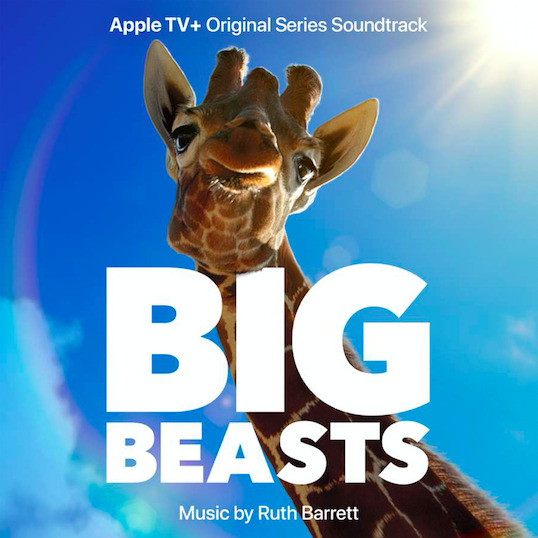
Lakeshore Records will release a soundtrack album for the Apple TV+ documentary series Big Beasts. The album features selections of the show’s original music composed by Ruth Barrett (Bodyguard, Victoria, Sanditon, The Terminal List, Collateral, Harry Brown). The soundtrack will be released digitally this Friday, April 21. Check back on this page for the streaming/download link. Big Beasts is executive produced by Tom Hugh-Jones, Martha Holmes & Grant Mansfield and takes audiences on a journey around the globe, from freezing poles to tropical rainforests, to meet nature’s most captivating giants. The 10-parter narrated by Tom Hiddleston was filmed across seventeen countries and captures rare footage using specialized equipment and next-generation filming technique. The series will premiere on April 21 exclusively on Apple TV+.
Here’s the track list of the album:
. Ostrich in the Savannah (3:53)
2. Pacific Whales (2:41)
3. Mother Octopus – Ruth Barrett & Claudio Olachea (3:00)
4. Okavango Flood (2:02)
5. Elephant Calf Survival (2:16)
6. Gorilla Makumba (1:35)
7. Magnificent Mandrills – Ruth Barrett & Claudio Olachea (1:29)
8. Enter the Congo Bai (1:49)
9. Giant Otters of the Pantanal – Ruth Barrett & Claudio Olachea (3:21)
10. Brazilian Anteater (2:39)
11. Orangutans of Borneo (3:04)
12. Proboscis Monkey – Ruth Barrett & Claudio Olachea (1:22)
13. Indian Tiger Kingdom – Ruth Barrett & Dom James (3:30)
14. King Cobras Duel – Ruth Barrett & Claudio Olachea (3:15)
15. Bearfight in the Rockies (2:25)
16. The Polar Bear’s Voyage (3:28)
17. Antarctic Elephant Seals (2:27)
18. Orca Attack – Ruth Barrett & Claudio Olachea (1:10)
19. The Albatross Learns to Fly – Ruth Barrett & Dom James (2:45)
20. Leopard Seal vs. Gentoo Penguin – Ruth Barrett & Claudio Olachea (1:57)
21. The Humpback Whale’s Miracle (2:28)
youtube
24 notes
·
View notes
Text
Brazil's Amazon Fund: A global climate blueprint?
Ahead of the COP28 climate conference, Brazil wants to see more cooperation among countries of the Global South and is looking for industrialized nations to provide the funds they pledged but so far failed to deliver.

The COP28 UN climate conference, held from November 30 to December 12 in Dubai, is all about money.
Attendees will discuss who will pay how much for efforts to slow climate change and mitigation measures to cope with it.
Ahead of the conference, Brazilian President Luiz Inacio Lula da Silva said industrialized countries should foot the bill — echoing a sentiment shared by many developing and emerging economies.
After four years under the leadership of his predecessor, Jair Bolsonaro, Lula's Brazil is now once again eager to lead on climate protection.
One of the tools for doing so is its very own Amazon Fund. It was set up in August 2008, with Norway contributing 90% of the funds and Germany 10%. The financial instrument has been revived since Lula returned to office in 2023.
The Amazon Fund is unique in that it used to support climate projects outside Brazil. This includes, for example, providing financial and technical support for satellite monitoring of the Amazon rainforest in Bolivia, Colombia, Ecuador, Peru, Venezuela, Guyana and Suriname.
The fund has also paid for rainforest conservation efforts along the Mekong River in the Republic of Congo, the Democratic Republic of the Congo as well as in Borneo.
"South-South cooperation is possible. It was planned from the outset," Nabil Moura Kadri from Brazil's BNDES development bank told DW. BNDES administers the Amazon Fund.
Continue reading.
#brazilian politics#brazil#politics#environmentalism#foreign policy#mod nise da silveira#image description in alt
4 notes
·
View notes
Note
FROG TIME!!
Today’s frog is
🥁🥁brdbrdbrbdbrrbrrbdbrbrbrbdbrbdbrddbbdbrbdbrbdbd🥁🥁
The Malayan horned frog!!!
The Malayan horned frog (Megophrys nasuta) also known as the Long-nosed horned frog is a type of frog that is restricted to rainforest areas ranging from southern Thailand and peninsular Malaysia to Singapore, Sumatra, and Borneo.

According to the IUCN red list the Malayan horned frog is of least concern as of the last assessment dated August 1st, 2014.
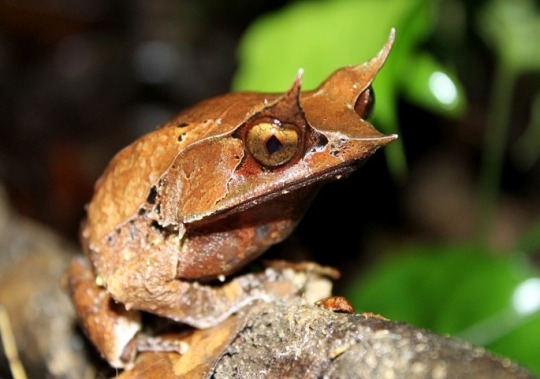
The Malayan horned frog lives in permanently damp, and cool lowland and submontane rainforests among leaf litter.
Breeding usually takes place in streams, and the female frogs attach the eggs to the underside of partially or fully submerged rocks or logs.
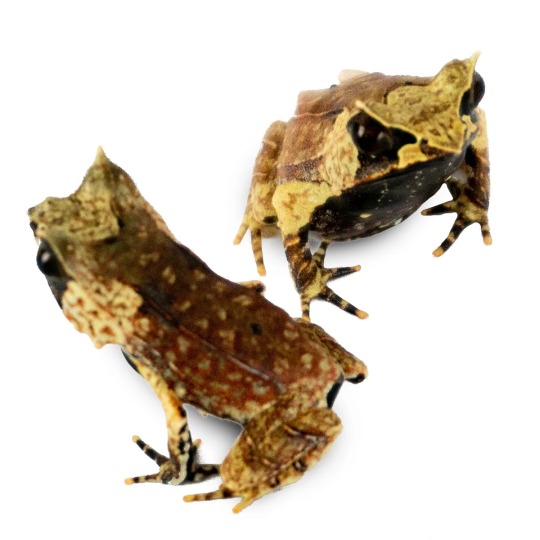
The Malayan horned frog has a snout-vent length of 10 cm to 12 cm (4 in to 4.7 in), and they live for an average of about five years(?)(information is scarce T~T).

They are light to dark brown on the dorsal surface with varying patterns and camouflage very well with the forest floor. The throat is black-dark brown and diffuses into cream-yellow halfway along the ventral surface.
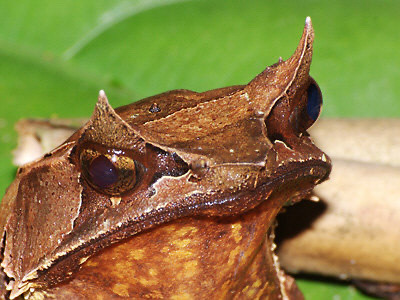
The upper eyelids and snout are drawn out into long triangular projections, forming what looks like "horns", giving them their common name. The toes are slightly webbed and the fingers are free from webbing.
This has been your suprise frog dossier, thank you and goodnight(or whatever time you read this)
Sincerely,
Thē
Thank you so much you just made my day
3 notes
·
View notes
Text


Ascended Master and list of the Day
September 27th, 2022
Tuesday
Sebastian
Root chakra
Today is Turmeric, the flame, flavor, ray of light, color, candle,and coffee
Turmeric the ground Spice
Spirit animal Bay Cat
Ascended Master Sebastian
Planet Neptune
Number Six
Elohim Mind
Element Air
Star Lucy
Country Borneo
Gemstone Labradorite
Day Galaxy
Day of the Nymph
Divinity Feminine Masculine
Keyword Renaissance
Gabriel and Bailey day one, and Gabriel’s day
Sunrise 6:44 AM to 6:40 PM in Libra
Forecast 56 - 43 degrees, sunrise and clouds
Moonrise 8:30 AM to 7:40 PM waxing crescent in Libra until 6:12 turning into Scorpio
Notes: Blue, Rose Gold, swamp forests and hill forests, Ruby, Indonesia, generosity, confidence
🧡
Tarot
Sign from Above
Guardian Angel
Heaven is sending you blessings and answers in the form of signs in the physical world. This card asks you to pay extra attention to signs, as they are part of the answer to your question.
Three or more times is a definite answer.
Trust in these signs you receive, and know that they are very real and meaningful to you.
The other for notable cards from this deck are, Pray, Guardian angel; Confidence, St. Michael the Archangel; Activist, St. Mother Teresa; Healing, St. Padre Pio
Pray, the answer to your questions involves prayer. You are being guided to pray about the situation in order to elicit answers and assistance. Your guardian angels pray with you. Ask for divine intervention to help you and your love ones.
Your purpose also involves prayer as well. Prayer is extremely effective, so by engaging in this practice, you’re making a tremendous contribution. It is not always the words of all that your heroes, compared to your sincere desire to connect with the divine and your own heart.
Confidence, remember that you are ultimately in charge of your schedule. Stay connected and committed to your priorities, and give them the daily attention they deserve.
Activist, notice which issues engage your senses, your soul want to express itself. Use your expertise and life experience to help along your chosen causes.
By transforming your faith into living acts of love, we put ourselves in contact with God, and Jesus our Lord.
Healing, this card signifies the power of prayer. Does it tuition is surrounded by gods rejuvenating love and is resolving itself in a miraculous way. This message signifies you may want to continue your prayers, and even pray in a group. It is also a call from heaven for you to use your talents and healing abilities to help in a more powerful way.
Saints and Angels Oracle Deck
🧡
Photo of the day
Tahquamenon Falls
🧡
Book of the day
Your Galactic Neighbors
by Sheldan Nidle
🧡
Turmeric Coffee ☕️
🧡
Borneo is known for its beaches in ancient, biodiverse rainforest, home to wildlife including orangutans and clouded leopards.
Staple cuisine includes fried rice, noodles, and local vegetable seasoned with garlic, ginger, and rich sauces with a side of fruits.
The bay cat has a bright chestnut color with a paler color beneath. The tail is elongated and tapering at the end. They enjoy being near water.
Labradorite
Can be used to influence positive changes in one’s life. It works well with the crown, sir diet, and throat chakra is. This gem stone is said to hold some of the Northern Lights, Inuit beliefs.
The geological area for this gemstone is said to be Paul Island, near the town of Nain in Labrador, Canada.
It has also been reported in Norway, Finland, with a notable distribution in Madagascar, China, Australia, Slovakia, and the United States of America. It is also found in metamorphic and amphibolites.
It assists you in getting in touch with your own wisdom.
Nymphs dwell in mountains, for us, trees, and waters. They are A nature spirit associated with life, fertility, and growth. They have a deep sense of mystic storytelling and art. They assist you in connecting with the soulful dimensions of life.
Turmeric symbolizes and represents purity and spiritual connection, more intently with the earth. It’s deep yellow color is typically associated with the sun and abundance along with the sacral chakra.
#saint sebastian#tuesday#September 27th#saint Lucy#Star#turmeric#root#book of the day#photooftheday#photography#inspiration#coffee#life#energy#beauty#waterfall#galactic neighbor#tarot#art#tahquameon falls#sign from above#air#mind#Borneo#Neptune#renaissance#bay cat#six#labradorite#love
0 notes
Text
“Luxury travel is getting more adventurous than ever before” — this company is offering a £1m trip
Well certain individuals plainly are that pushed, in light of the fact that they're doing precisely that. And no, you couldn't actually bring along the entire family at that weighty cost tag. That is just the cost for two individuals.
The bundle occasion, costing £1m ($1.32m), does anyway offer visitors the opportunity to get up near 18 imperiled species, across 12 nations, more than 111 days.
From Northern White Rhinos to Bengal Tigers, the excursion places visitors in the territories of the absolute most imperiled species on the planet.
Destinations include Antartica, the Galapagos Islands and Borneo to give some examples, and the excursion is appropriately named Excursion to Nature's Edge.
Will Bolsover, the organizer behind travel organization Normal World Safaris that has the expensive bundle occasion.
"Luxury travel market is getting more brave than any other time," explains Bolsover, "and that is the very thing that individuals need."
Surprisingly, the excursion doesn't highlight 5-star luxury
The convenience isn't the full fancy odds and ends, in spite of what you could anticipate from the sticker price.
In Antarctica, visitors stay in Whichaway Camp, an eco-camp of little unit like cabins controlled exclusively by wind and sun based power. The most rich conveniences are common showers and composting latrines.
For more insights on the luxury travel market trends, download a free report sample
Anyway Bolsover insists that these elements all give visitors a more real encounter.
"We once had a few clients who were driving down a street in a rainforest on one of our excursions. They stalled out and were there short-term until a clan of dwarfs, who were traveling through the rainforest, recovered them with natively constructed scoops."
Instead of being irate for the inconvenience, the visitors were evidently energized at the experience.
0 notes
Text
That one biology essay I said I would share even if nobody cared.
What are genetic diversity and species diversity?
Genetic diversity is defined as “the range and variety of genes species and habitats within a particular region” and species diversity being “the number of different species and the number of individuals of each species within any one community” [1]
How does genetic diversity arise?
Genetic diversity can arise from mutations which over time create new alleles, giving rise to new characteristics or equally can arise from genetic recombination, a process that happens in a cell during prophase 1 of meiosis. Genetic recombination allows genetic material to be exchanged between two molecules of DNA. [13] A genetically diverse population arises from having a large gene pool, enabling lots of different combinations of alleles.
Problems that will arise because of lack of genetic diversity?
Reduced biodiversity means millions of people face a future where food supplies are more vulnerable to pests and disease, and where fresh water is in irregular or short supply. [11] Why is this? As genetic diversity decreases, due to monocultures, if the monoculture does not have an allele resistant to a possible new disease or pest or change in condition, they will all die. There will be no survivors as they would all have the exact same genes, whereas a genetically diverse population would have some survivors... ‘survival of the fittest’, allowing those to pass on those beneficial alleles to their offspring. However, if all our food supply were dependent on huge fields of monocultures, all it could take would be a single disease that would wipe out an entire food supply. Lack of genetic diversity leaves a species dangerously close to a very quick extinction. [12]
Causes in decrease of genetic and biodiversity diversity?
Deforestation and habitat destruction which often is caused by farming, such as the deforestation of the amazon rainforest in Brazil. Researchers used records of more than 14,500 plant and vertebrate species to create biodiversity maps of the Amazon region, they found that since 2001, between 40,000 and 73,400 square miles of Amazon rainforest have been impacted by fires, affecting 95% of all Amazonian species and as many as 85% of species that are listed as threatened in this region. The fires are not natural of the rainforest, they are purposely caused by humans for using the land to grow crops instead. [9] In Borneo, palm oil plantations have largely been the cause of deforestation of the rainforest, this has lead to the dramatic decline of the Bornean orangutan which currently have a population of 100,000 in the wild, compared to 300,000 in 1973. By 2025, it is expected for the population to decrease by a further 22% . [15]
Habitat Fragmentation is a major cause of extinctions. Fragmentation is the breaking up of habitat into smaller patches. The habitats often become too small to hold a complex enough ecosystem, leading to it breaking down completely. This is in a way strongly related to habitat destruction. Habitat fragmentation also leads to many organisms being exposed and therefore venerable to predators or human hunters. Fragmentation also leads to the separation of species from resources, meaning that they do not have access to enough food or water to be able to survive. This effect decreases genetic diversity as there is less gene flow, due to the populations being separated or ‘isolated’ and as a result the gene pool decreases. [17]
Due to the use of pesticides, a third of bees in Britain are in decline, some populations having experienced a decrease of over 50% in the most recent 30 years. This is not only a significant issue concerning genetic diversity but is also a significant financial issue. The pollination of agricultural crops by the honeybee is estimated to be around $117 billion a year globally, proving to be critical to agricultural systems. [14]
Over exploitation of natural resources such as trees can lead to habitat loss. Organisms that previously lived around those natural resources are displaced, resulting in biodiversity loss.
Pollution and acidified water are more of an unthought threat to biodiversity, an example of this would be in France where from 1994, 20% of France’s forests have been damaged from acid rain. [10] Acid rain causes the decrease in pH of the water and soil, changing the species able to survive in these conditions. Acid rain causes a cascade of effects that harm or kill individual fish, reduce population numbers, completely eliminate species from a lake, and decrease biodiversity
How can we help preserve biodiversity?
There are many things we can do to help maintain biodiversity, here are just a few... Leave critical wildlife habitat undisturbed, especially nesting. Promote wildlife use by setting up bird and bat houses or even creating homes from bamboo for solitary bees, eradicate and control introduced weeds on your property such as the invasive Japanese knotweed, keep vehicles on main roads to reduce the disturbance to wildlife, reduce the amount of large new housing estate builds, support native species growth.
Protected areas are an extremely important part of programs to conserve biodiversity and ecosystems, especially for sensitive habitats [6]. Protected areas essentially stop unsustainable tourism, illegal harvesting of plants and animals and protect local species from invasive species.
An example of a protected area aiding the survival of local species from invasive species are woodland agencies which manage the habitat (in this case coniferous woodlands) such as the RSST (Red squirrel survival trust) which ‘Protect red squirrels by keeping reds and greys apart’ or the RSTW (red squirrel trust Wales) which protects the red squirrel from going extinct by eradicating the grey squirrels which are native to the eastern and midwestern USA. The grey squirrel (imported into the UK in 1876) is a major threat to the red squirrel population. It is said that for every red squirrel in England, there are 70 grey squirrels. Grey squirrels are not only much bigger than Reds, enabling them to have access to the limited food resources, but also the Grey has a much more varied diet, not being dependent on green acorns like the red. As well as this, the native US breed is far more prolific than the native breed of our country, having 2 litters a year as opposed to just 1. [18] [7]
Another method in the fields of agriculture is to replant hedgerows, providing more different habitats and different food sources resulting in more different species being attracted. However, the issue with this would be that farmers would have less land to grow crops, resulting in lower yield and income, so to help the farmers the government have a funding scheme. According to the Uk government website, the hedgerows must also be composed of at least 80% native shrubs. There are also other criteria to reach to be elidable for the funding such as leaving ‘the hedgerow at least 50% uncut’ which is said to increase the amount of pollen or berries available for the insects and birds- again increasing biodiversity [8]
Hedgerows make good habitats for hedgehogs, due to reduced hedgerows, hedgehog populations have been in decline. Along with the use of pesticides that have decreased the number of invertebrate preys of the hedgehog, other factors such as large housing developments have contributed to the decline. However, we can reduce our impact on the decline of hedgehogs by not having paving or decking in our gardens, increasing the number of plants, and therefore increasing the food sources for these mammals. Again, not using pesticides in our gardens will reduce deaths of hedgehogs. [14]
Restoring estuarine and coastal habitats is vital for aiding biodiversity. It has been reported that these habitats are some of the most biologically diverse habitats in the whole of the UK. In just 200 years, 98% of oyster reefs and 85% of saltmarshes have been lost. However, the UK government in January 2018, published ‘the 25 Year Environment Plan’ which set to reverse and restore marine biodiversity by improving environmental quality (air, soil, geology, and water) [16]
Returning and restoring lost native species will reverse loss and increase biodiversity. An example of this is the reintroduction of beavers in England and Scotland in 2009. The activity of Beavers and the environment they create have aided the restoration of wetlands, woodland, and riparian habitats. A substantial proportion of plants, mammals, amphibians, birds, and mammals rely on beaver created environments to flourish. [19]
To summarize, humans have had a drastic impact on biodiversity and genetic diversity, this is through the effect of simplifying ecosystems such as the rainforest for palm oil or forest for monocultures or housing. Landscape simplification and monocultures have been introduced over many centuries to cope with the growing human world population.
References:
[1] Book: Oxford AQA Biology A LEVEL 2nd Edition – Glenn Toole, Susan Toole.
Date of first publication: 2015
ISBN: 978-0-19-8351771
[2] website: https://www.ncbi.nlm.nih.gov/pmc/articles/PMC3399204/#:~:text=Inbreeding%2C%20genetic%20drift%2C%20restricted%20gene,of%20extinction%20(Saccheri%20et%20al
Date accessed: 10/06/22 and 12/06/22
[3] Website: https://www.pnas.org/doi/10.1073/pnas.2104642118
Date accessed: 10/06/22 and 12/06/22
[4] website: https://www.science.org/content/article/boosting-genetic-diversity-may-save-vanishing-animal-populations-it-may-also-backfire
Date accessed: 10/06/22 and 12/06/22
[5] website: https://royalsociety.org/topics-policy/projects/biodiversity/why-is-biodiversity-important/#:~:text=Biodiversity%20is%20essential%20for%20the,also%20value%20nature%20of%20itself
Date accessed: 10/06/22 and 12/06/22
[6] website: http://www.greenfacts.org/en/biodiversity/l-3/6-conserve-biodiversity.htm
Date accessed: 14/06/22
[7] website: http://www.britishredsquirrel.org/squirrel-organisations/
Date accessed: 17/06/22
[8] website: https://www.gov.uk/guidance/hedgerows-standard
Date accessed: 17/06/22
[9] website: https://today.uconn.edu/2021/09/study-shows-the-impacts-of-deforestation-and-forest-burning-on-biodiversity-in-the-amazon/
Date accessed: 17/06/22
[10] website: https://www.nationsencyclopedia.com/Europe/France-ENVIRONMENT.html#:~:text=As%20of%201994%2C%2020%25%20of,%2C%20waste%20disposal%2C%20and%20chemicals.
Date accessed: 17/06/22
[11] website: https://wwf.panda.org/discover/our_focus/biodiversity/biodiversity_and_you/#:~:text=Biodiversity%20underpins%20the%20health%20of,in%20irregular%20or%20short%20supply.
Date accessed: 19/06/22
[12] website: https://www.naturetrust.bc.ca/conserving-land/what-can-we-do#:~:text=Leave%20critical%20wildlife%20habitat%20undisturbed,weeds%20and%20disturbance%20to%20wildlife.
Date accessed: 20/06/22
[13] website: https://www.nature.com/scitable/topicpage/dna-is-constantly-changing-through-the-process-6524876/
Date accessed: 20/06/22
[14] magazine: advanced biology, biological sciences review, Hodder education, November 2020, Volume 33, Number 2.
ISBN: 9781 398309159
[15] magazine: advanced biology, biological sciences review, Hodder education, September 2019, Volume 32, Number 1.
ISBN: 9781 510470309
[16] magazine: advanced biology, biological sciences review, Hodder education, February 2021, Volume 33, Number 3
ISBN: 9781 398309166
[17] magazine: advanced biology, biological sciences review, Hodder education, September 2020, Volume 33, Number 1
ISBN: 9781 398309142
[18] magazine: advanced biology, biological sciences review, Hodder education, April 2020, Volume 32, Number 4
ISBN: 9781 510470330
[19] magazine: advanced biology, biological sciences review, Hodder education, April 2021, Volume 33, Number 4
ISBN: 9781398309173
#if some of it is incoherent it is because not once did i proofread#and that isn't an attempted flex... i genuinely couldn't bring myself to read my own work lol#basically im lazy#in terms of proofreading and planning#i didn't plan my essay. so if i had to guess. my ideas are all over the place#if you did read any of my essay... i hope you learnt something???#i had mild fun writing it. i liked looking at the pictures in magazines of cute beavers and squirrels#i couldn't make a good conclusion. i know it is bad. but like how does one write a conclusion???
1 note
·
View note
Text
Giant banana, night-flowering orchid, ant-loving tree with animal-like tissue, 68% of plant species live only on the island and nowhere else, 4-times as many tree species on the island than on the continent of North America, over 2800 species of orchids:



Sitting just below the equator at the nexus of Asia and Australia-anchored Oceania, the island’s expansive coastline rings a rugged interior that stretches to 4,000-meter-high (13,000-foot) mountains and active volcanoes. The people who live on the island speak more than a thousand languages. And there are 843 species of birds alone that call the island home [...]. So it was little surprise to many [...] when a study cataloging New Guinea’s plant species came out Aug. 5 in the journal Nature, confirming that it’s the most botanically diverse island on Earth. [First headline from The Guardian, August 2020. Second headline from The Conversation, 12 August 2020. Text excerpt: John C. Cannon. “Study revealing New Guinea’s plant life ‘first step’ toward protection. 25 August 2020.]
The research concludes New Guinea has 13,634 species of plants from 1742 genera and 264 families. That gives New Guinea, the world’s second largest island, the highest plant diversity of any island on Earth, surpassing Madagascar (11,832 species), Borneo (11,165 species), and Sumatra (8,391 species). New Guinea ’s plant diversity is greater than that of the entire archipelago of the Philippines (9,432 species). Just five families account for more than a third of plant species on the island. Orchids, with 2,856 species or 21% of the island’s species, are the most diverse. There are 3,962 species of trees in New Guinea or about four times the number found across all of North America. New Guinea’s flora is also highly unique. The study finds that more than two-thirds of its plants are endemic, meaning they are only found on the island. [Text excerpt: Mongabay as republished at Earth News. “New Guinea has the most plant species of any island.” 6 August 2020.]
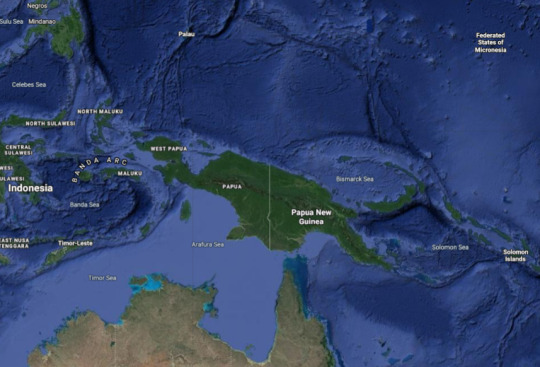
The article:

New Guinea is [...] [h]ome to some of the best-preserved ecosystems on the planet and to intact ecological gradients -- from mangroves to tropical alpine grasslands -- that are unmatched [...]. Here we present the first, to our knowledge, expert-verified checklist of the vascular plants of mainland New Guinea and surrounding islands. [Text excerpt: Camara-Leret et al.]
Elsewhere, the original authors of the article describe their favorite plants [Excerpts from: Bruce Webber, Barry Conn, and Rodrigo Camarao-Leret. ‘Majestic, stunning, intriguing and bizarre’: New Guinea has 13,634 species of plants, and these are some of our favorites.” The Conversation. 12 August 2020.]

Ryparosa amplifolia maintains an intimate association with ants via hollow stems and food bodies. [...] Then there’s the Ryparosa amplifolia, a rainforest tree that provides swollen hollow stems for ant colonies to live inside. The tree also produces energy rich “food bodies” – granule-like structures on the leaves that mimic animal tissue and provide the ants with sustenance. In return, the ants act as bodyguards, chasing away insect herbivores, and leaf cleaners. [Text: Webber et al. “Majestic...”]

With more than 2,400 species of native orchid species, New Guinea is one of the most spectacular floral gardens in the world. It includes fascinating species such as Bulbophyllum nocturnum, which is the first and only known example of a night-flowering orchid, and Bulbophyllum tarantula, with appendages that resemble the iconic spider. [Text: Webber et al. “Majestic ...”]

Some of our most popular foods were domesticated from New Guinea, including sugarcane and bananas. But the giant banana, Musa ingens is a a highlight in montane forests. Its leaves can stretch to a length of 5 metres, the tree can grow more than 20 metres tall, and its fruits are massive. [Text: Webber et al. “Majestic ...”]
Some graphics from the academic article:



--


370 notes
·
View notes
Text
The Monkey Family
The apes
Many people confuse monkeys and apes. Apes are large, intelligent creatures that have no visible tails and can stand more upright than monkeys. You and I are members of the ape family.

The mighty gorilla
Gorillas are the largest and the most powerful of the ape family, but they are not aggressive. They live in forests in central Africa.

Family life
Gorillas live in group of up to 40 animals, which consists of one male and many females and babies. The males are twice the size of females and as they mature they grow a strip of silvery fur across their backs.
King of the swingers
Gibbons are the most agile of all the apes. Their wrists and shoulders are very flexible, which means they are able to swing from branch to branch quickly. They live in pairs.

Treetop apes
These orange orang-utans live in the rainforests of Borneo and Sumatra up in the trees. They rarely go down to the jungle floor, preferring to eat and sleep in the treetops.

Grooming
Chimps live in communities of up to 12 apes. Grooming is very important in ape societies. They can often be seen picking dirt and ticks out of each other’s fur.
Treetops
All monkeys are excellent climbers – some have long tails that they use as another limb. The spider monkey’s tail is bald at the end for extra grip.

Ground monkey
The mandrill is one of the few monkeys that only climbs trees to sleep at night. During the day it walks around on all fours. When a male feels threatened it yawns widely revealing its fearsome teeth.
Bushbaby
The bushbaby is a small primate that sleeps during the day and ventures out to hunt at night. It has huge eyes that help it see in the dark.
Lemurs and monkeys
Monkeys and lemurs, along with the apes, make up the mammal group known as primates.

The loudest land animal on earth
Talking to each other is important to primates, which live together in large groups. This howler monkey screams to neighbouring groups and can be heard several miles away.
Lemurs
Lemurs are found only on the island of Madagascar, in the Indian ocean. They have thin bodies and often move by jumping along on their back legs. Sitting upright with its hands on its knees, this ring-tailed lemur is sunbathing.
Monkey business

Most people think monkeys all look familiar, but some are quite different.
White-faced saki: the male is black and female is brown
Tamarin: the golden lion tamarin has gold fur and a long mane.
Woolly monkey: it lives in South America and has thick fur.
Proboscis monkey: the male monkey has a very long, prominent nose.
Monkeys
Monkeys have grasping hands so they can climb trees. Many have recognizable features, like this tamarin’s white moustache.

source: encyclopedia, google.
3 notes
·
View notes
Text
Best Parosphromenus spp. (”Licorice Gouramis”)
All species of Parosphromenus, to my knowledge, come from habitats that are under threat. Most species are designated Endangered or Critically Endangered by the IUCN Red List. Any fish from this genus should be maintained in a species tank and breeding should be attempted if we are going to continue to maintain them in the hobby, and perhaps through hobby preservation, prevent the loss of these species from the world. Check out the Parosphromenus Project for more information on preservation efforts.
(Though I should note that I have reservations about the efficacy of projects aimed to “preserve species through the hobby.” See a post here where I discuss this some.)
These are gorgeous little fishes I’ve loved since I first got into the fish keeping hobby, but I’ve yet to have the opportunity to keep any. They are rare in the trade, for good reason, and I have yet to be in a situation where I had a tank ready and felt comfortable with acquiring some. As I look forward to setting up a fish room, the time has come that I will absolutely be seriously shopping for some ethically sourced Parosphromenus (likely hobby-bred). No matter how high my interest is in a species, I will not keep it if I cannot source it without acquiring a wild-caught specimen of an imperiled species being sold indiscriminately to the hobby at large.
Below is a ranked list of Parosphromenus to help me prioritize species to keep, should I have the opportunity to pick and choose between species. Rankings are based purely on subjective opinion, prioritizing those whose aesthetics I prefer. These are all great fishes!
1. P. harveyi
Size: 4.0cm / 1.57in TL
Habitat: Malaysian peat swamps
IUCN Redlist Status: Endangered
2. P. deissneri
Size: 5.0cm / 1.97in TL
Habitat: Indonesian tannic, vegetated streams
IUCN Redlist Status: Endangered
3. P. bintan
Size: 3.5cm / 1.38in TL
Habitat: Peat swamps of Bintan Island, Indonesia
IUCN Redlist Status: Vulnerable
4. P. rubrimontis
Size: 3.5cm / 1.38in TL
Habitat: Blackwater creeks to peat swamps of Perak, Malaysia
IUCN Redlist Status: Endangered
5. P. filamentosus
Size: 4.5cm / 1.77in TL
Habitat: River systems in Kalimantan Tengah, Central Borneo
IUCN Redlist Status: Endangered
6. P. alfredi
Size: 2.6cm / 1.02in SL
Habitat: Remnants of peat swamps in Western Malaysia
IUCN Redlist Status: Critically Endangered
7. P. quindecim
Size: 2.9cm / 1.14in SL
Habitat: Sungai Pawang and Sungai Liong basins of Kalimantan Barat, Western Borneo
IUCN Redlist Status: Critically Endangered
8. P. gunawani
Size: 4.5cm / 1.77in TL
Habitat: Peat swamp in Jambi, Sumatra
IUCN Redlist Status: Critically Endangered
9. P. nagyi
Size: 4.0cm / 1.57in TL
Habitat: Peat swamps and creeks in Western Malaysia
IUCN Redlist Status: Vulnerable
10. P. phoenicurus
Size: 4.0cm / 1.57in TL
Habitat: Blackwater swamp in the Sungai Kampar drainage, Sumatra
IUCN Redlist Status: Critically Endangered
11. P. tweediei
Size: 4.0cm / 1.57in TL
Habitat: Johor, Malaysia - Original habitat may have been peat swamps and streams, appears to now only be found in man-made roadside channels fed by blackwater springs
IUCN Redlist Status: Endangered
12. P. sumatranus
Size: 3.5cm / 1.38in TL
Habitat: Highly soft and acidic waters in Sumatra, Indonesia
IUCN Redlist Status: Near Threatened
13. P. allani
Size: 4.0cm / 1.57in TL
Habitat: Wetland and forest habitats of Sarawak, Borneo
IUCN Redlist Status: Vulnerable
14. P. parvulus
Size: 3.5cm / 1.38in TL
Habitat: Creeks bordering rainforests in Kalimantan Tengah, Central Borneo
IUCN Redlist Status: Vulnerable
15. P. anjunganensis
Size: 3.5cm / 1.38in TL
Habitat: Blackwater habitats in the Kapuas River system, Kalimantan Barat, Western Borneo
IUCN Redlist Status: Endangered
16. P. opallios
Size: 3.5cm / 1.38in TL
Habitat: Highly vegetated, shallow, and extremely soft and acidic waters in Kalimantan Tengah, Central Borneo
IUCN Redlist Status: Endangered
17. P. ornaticauda
Size: 3.5 cm / 1.38in TL
Habitat: Blackwater habitats in the Kapuas River system and Sungai Pawan basin, Kalimantan Barat, Western Borneo
IUCN Redlist Status: Critically Endangered
18. P. pahuensis
Size: 4.0cm / 1.57in TL
Habitat: Small blackwater forest streams; Tributaries of the Mahakam River in Kalimantan Timur, Eastern Borneo
IUCN Redlist Status: Endangered
19. P. linkei
Size: 4.5cm / 1.77in TL
Habitat: Wide distribution in highly destroyed parts of Kalimantan Tengah, Central Borneo
IUCN Redlist Status: Endangered
20. P. paludicola
Size: 3.7cm / 1.46in TL
Habitat: Widely distributed through both light blackwater and clearwater habitats in the northeastern Malay Peninsula and southern Thailand
IUCN Redlist Status: Endangered
[Data from the Parosphromenus Project, Fishbase, SeriouslyFish, and the IUCN Red List. I will need to do further research using scholarly articles before keeping any of these. When sizes were in conflict between sources, the largest listed size was used.
Note that in doing my reading for this post, it became clear that SeriouslyFish copied and pasted info about peat swamps to every page about a species of Parosphromenus - but they do not all occur in the conditions described. So I stopped including information from SF partway through writing this. When considering housing and breeding one of these fishes, I would recommend sourcing information about their care elsewhere - ideally from primary scientific literature, as I intend to.]
3 notes
·
View notes
Text
Degraded soils mean tropical forests may never fully recover from logging
https://sciencespies.com/environment/degraded-soils-mean-tropical-forests-may-never-fully-recover-from-logging/
Degraded soils mean tropical forests may never fully recover from logging


Logging in the rainforest of Kalimantan. Credit: Kate Davison/Greenpeace
Continually logging and re-growing tropical forests to supply timber is reducing the levels of vital nutrients in the soil, which may limit future forest growth and recovery, a new study suggests. This raises concerns about the long-term sustainability of logging in the tropics.
Trees of recovering tropical forests were found to have tougher leaves, with lower concentrations of the nutrients phosphorus and nitrogen—both essential for plant and tree growth—than trees of old-growth forests. This suggests that multiple cycles of logging and recovery irreversibly remove phosphorus from the forest system, and are pushing the nutrient content towards ecological limits.
“Old-growth tropical forests that have been the same for millions of years are now changing irreversibly due to repeated logging,” said Dr. Tom Swinfield, a plant scientist in the University of Cambridge Conservation Research Institute, and first author of the paper published in the journal Global Change Biology.
Soil nutrients including phosphorus come from rocks, and are taken up by trees through their roots. Cutting down the trees causes these nutrients to be lost through soil erosion, gas emissions, and removal of nutrients in the extracted timber. The researchers estimate that as much as 30% of the available phosphorus in the soil is being removed from tropical forest systems by repeated logging.
“We see that as the logged forests start recovering, they’re actually diverging from the old growth forests in terms of their leaf chemistry and possibly also species composition, as the amount of available nutrients goes down,” said Swinfield. “At the moment the trees can cope, but the fact that they’re changing indicates phosphorus levels in the soil are dropping. This could affect the speed at which forests recover from future disturbances.”
The researchers created high definition images of a forest landscape in north-eastern Borneo using LIDAR-guided imaging spectroscopy from an aircraft. This is a method of remote sensing, using a laser scanner and high fidelity camera, which takes hundreds of measurements across the light spectrum. They combined this information with nutrient measurements from 700 individual trees in the forest. This allowed them to map the concentrations of nutrients in the trees’ leaves over an area containing repeatedly logged forest and old-growth forest, and compare the two.
This is the first landscape-scale study of how leaf function changes in response to logging. Selective logging is carried out extensively across millions of hectares of forest in the tropics, so that degraded forests are now more widespread than old-growth forests. The study suggests that each consecutive harvest reduces the level of nutrients in the system, and newly established trees have to adapt to conserve the scarce resources available to them.
“Phosphorus limitation is a really serious global issue: it’s one of the areas where humans are using a vital resource beyond sustainable levels,” said Professor David Coomes, Director of the University of Cambridge Conservation Research Institute, who led the project. The researchers found that differences from old-growth forest become more pronounced as logged forests grow larger over time, suggesting exacerbated phosphorus limitation as forests recover.
Explore further
Forest soil needs decades or centuries to recover from fires and logging
More information:
Global Change Biology (2019). DOI: 10.1111/GCB.14903
Provided by
University of Cambridge
Citation:
Degraded soils mean tropical forests may never fully recover from logging (2019, December 16)
retrieved 16 December 2019
from https://phys.org/news/2019-12-degraded-soils-tropical-forests-fully.html
This document is subject to copyright. Apart from any fair dealing for the purpose of private study or research, no
part may be reproduced without the written permission. The content is provided for information purposes only.
#Environment
1 note
·
View note
Photo

It's the festive season in Borneo again! This day we celebrate a wonderful culture, the epitome of strength & beauty. Original Art by HJ Chen - Frame 12. View full poster in profile. #comic #characterdesign #originalart #comicart #comicartist #inking #sketch #selamatharigawai #festival #caricaturestory #漫画 #原创 #原稿 #漫画原稿 #gawai #rainforest #sarawak #instaart #illustration #celebration #ethnic #kuching #digitalart (at Kuching, Malaysia) https://www.instagram.com/p/ByP79p2BEak/?igshid=18zwl7uyiyol3
#comic#characterdesign#originalart#comicart#comicartist#inking#sketch#selamatharigawai#festival#caricaturestory#漫画#原创#原稿#漫画原稿#gawai#rainforest#sarawak#instaart#illustration#celebration#ethnic#kuching#digitalart
1 note
·
View note
Text
Friday, April 15, 2022 Canadian TV Listings (Times Eastern)
WHERE CAN I FIND THOSE PREMIERES?:
IT'S THE SMALL THINGS, CHARLIE BROWN (Apple TV+)
ROAR (Apple TV +)
HANDCRAFTED HOTELS (discovery +)
RUGRATS (Paramount +)
SWIMMING WITH SHARKS (The Roku Channel)
THE CELLAR (Shudder)
TITANIC 666 (Tubi)
COME DANCE WITH ME (Global) 8:00pm
LA MADRINA: THE SAVAGE LIFE OF LORINE PADILLA (Crave 3) 9:50pm
BILL MAHER: #ADULTING (HBO Canada) 10:00pm
WHAT IS NOT PREMIERING IN CANADA TONIGHT
KILLER DESIGN (TBD - Lifetime Canada)
NEW TO AMAZON PRIME CANADA/CBC GEM/CRAVE TV/DISNEY + STAR/NETFLIX CANADA:
AMAZON PRIME CANADA
CHICAGO FIRE (Season 7)
CLIFFORD THE BIG RED DOG
THE CONTRACTOR
HOW TO SURVIVE BEING SINGLE (Season 2)
JACK & JILL
KIDS IN THE HALL: DEATH COMES TO TOWN
OUTER RANGE
VERDICT
CBC GEM
2040
EDEN: UNTAMED PLANET
THE PASSION OF AUGUSTINE (LA PASSION D’AUGUSTINE)
PEOPLE JUST DO NOTHING (Season 4)
CRAVE TV
THE GOOD FATHER: THE MARTIN MACNEILL STORY
GOODBYE CHRISTOPHER ROBIN
HALLOWEEN KILLS
LA MADRINA: THE SAVAGE LIFE OF LORINE PADILLA
NEEDLE IN A TIME STACK
PAUL RABLIAUSKAS: UNCLE
THE SECRET LIFE OF WALTER MITTY
SHARKTOPUS
SHARKTOPUS VS. PTERACUDA
SHARKTOPUS VS. WHALEWOLF
SISTERHOOD OF THE TRAVELLING PANTS 2
SISTERHOOD OF THE TRAVELLING PANTS
A STORK’S JOURNEY
SUPERMARKET SWEEP (Season 2)
UP DISH (Season 1)
WALK THE LINE
WELLINGTON PARANORMAL
WHIP IT
DISNEY + STAR
HYSTERICAL
SHE’S THE ONE
STUCK ON YOU
NETFLIX CANADA
ANATOMY OF A SCANDAL
CHOOSE OR DIE
HEIRS TO THE LAND
MAI
ONE PIECE FILM Z
GRAND SLAM OF CURLING
(SN) 12:00pm: Player’s Championship - Draw #14
(SN) 4:00pm: Player’s Championship - Draw #15
(SN Now) 8:00pm: Player’s Championship - Draw #16
MLB BASEBALL
(SN1) 2:00pm: Twins vs. Red Sox
(SN) 7:00pm: A’s vs. Jays
(TSN/TSN4/TSN5) 8:00pm: Angels vs. Rangers
(SN Now) 9:30pm: Astros vs. Mariners
BILLIE JEAN KING CUP TENNIS (SN Now) 6:45pm: Canada vs. Latvia
NHL HOCKEY
(TSN2) 7:00pm: Islanders vs. Habs
(TSN3) 7:00pm: Jets vs. Panthers
EDEN: UNTAMED PLANET (CBC) 8:00pm/9:00pm (SERIES PREMIERE): Borneo is the richest rainforest island of all; home to 40,000 species of plants and animals, 6,000 of them are unique, and more are discovered almost daily. In Episode Two, the Namib Desert is one of the oldest deserts of all; it's also one of the most diverse; with 50-degree temperatures and half a millimetre of rainfall annually.
FISHING FOR LOVE (City TV) 8:00pm: When Kendall, a successful restaurant designer, comes home to Mystic Bay for the annual Big Catch Festival, she finds herself in uncharted waters with town newcomer Zack.
CURIOUS CATERER: DYING FOR CHOCOLATE (W Network) 8:00pm: Goldy Berry is a Colorado caterer who's thrust into the role of town sleuth to help solve a friend's mysterious death. With the clock ticking, she strikes up an unlikely partnership with a detective to find the killer.
SQUEAKY CLEAN MYSTERIES: HAZARDOUS DUTY (Super Channel Heart & Home) 8:00pm: After dropping out of school on her way to a forensic science degree, Gabby St. Claire decides to start a crime scene cleaning business. During a routine job, she uncovers a murder weapon that the police overlooked.
NEEDLE IN A TIMESTACK (Crave) 9:00pm: Nick and Janine live in bliss until her ex warps time to try to tear them apart by using Nick's old girlfriend. As Nick's memories and reality disappear, he must decide what he's willing to sacrifice to save -- or let go of -- everything he loves.
THINK LIKE A DOG (Super Channel Fuse) 9:00pm: A 12-year-old boy develops a telepathic connection with his dog after a middle-school science experiment goes awry.
CRIME BEAT (Global) 10:00pm: Reporter Caryn Lieberman reveals how Larry Arnold's murder investigation is linked to the 1997 killing of a 20-year-old woman Sarah Whitehead, hundreds of kilometers away in North Bay, Ontario.
#cdntv#cancon#canadian tv#canadian tv listings#eden: untamed planet#crime beat#curling#mlb baseball#tennis#nhl hockey
0 notes
Text
How To Choose Your Indonesia Cruise

You'll be impressed by the many Indonesian cruise itineraries. However, it can be difficult to choose the right vessel and travel route. Our experts have researched the possibilities and have put together this extensive private cruises guide to guide you through your travel choices. Based on your needs starting at the top or the lowest point of this list. This will help guide your travel search.
Understand Your Ship Options
Many small boats of different sizes and designs sail Indonesia. You can go the way of day boats, but selecting a first-class, seaworthy and safe vessel is of the utmost importance among these far-flung islands. We highly suggest going off the traditional day-tour route to remote areas by way of expedition vessels. Our vessels with us in Indonesia vary from traditional wooden schooners that give off a romantic, authentic vibe, to luxury and exploration-focused modern expedition vessels, that travel further, faster, equipped with the most modern equipment. The type of ship you prefer along with amenities and other activities will help you reduce your private yacht charter choices.
Consider the Indonesia animals you'd like to observe
While wildlife encounters can never be guaranteed, scouting out endemic creatures is half the fun of adventure travel anywhere. Manta rays can be found and birds-of-paradise throughout Indonesia. But there are other geographical differences.
The Wallace Line is a famous ecological boundary that divides two eco-zones within Indonesia. Alfred Russel Wallace, a naturalist, created the "line" in 1859. It runs from Borneo through Sulawesi and ends at the Strait between Bali and Lombok. The journey along this line is thrilling for naturalists because it's among the most distinctive biogeographic areas on Earth. It is home to large terrestrial mammals west of the line (tigers and elephants and orangutans), while marsupials and Australian cockatoos can be seen east of it. Birds-of-paradiseand marsupials, as well as Australian Cockatoos can be found east of the line. The Indonesian island of Sulawesi is a fascinating exception to the Wallace Line with black macaques and tarsiers.
Seasonality: The Clues
Indonesia cruises can be booked all year round. However, cruise ships generally sail to certain regions during the drier and less windy months. If you're looking to sail Raja Ampat for example, make sure to plan your trip for the winter season (roughly October to February). There are many sailings between April and September If your course is an Bali cruise.
youtube
Select Your Indonesia Island or Region
With 750,000 sq miles, Indonesia is the world's largest island and seventh largest by combined sea-and-land area. You cannot see it all on one cruise, unless you have unlimited time. Understanding the region and understanding your travel objectives are vital. Here is a brief primer:
Lesser Sunda Islands: Flores, Komodo and Bali Cruises
Most popular itineraries private yacht charter can be found within the Lesser Sunda Islands. This could be due to the availability of an international airport in Bali or because the island is a popular name for travel due to its numerous resorts. From west to east the Lesser Sunda Islands comprise Bali, Lombok, Sumbawa, Flores, Sumba, Timor and the Alor archipelago, and the Barat Daya Islands and the Tanimbar Islands, with the most common expedition yacht charter routes sailing regularly between Bali and Flores.
Each of these islands is distinct in their own way with a myriad of earthy highlights, including waterfalls, volcanoes, rainforests and mangroves, white-sand beaches and even savannah. The varied landscape has a diverse range of wildlife, including Komodo dragons and manta Rays. Traditional lifestyles, peaceful villages along the coast, tribal customs and fascinating ancestral customs are also a major draw for travelers to the Lesser Sundas.
Know You Can Make Your Own Way: Indonesia Charters
Chartering your own boat is a great option for families and groups, as ship sizes vary from 12 to 120 guests on our Indonesia cruises. Contact our experts about a charter which could result in savings per cabin and flexible routes, that allow you to create your ideal itinerary.
Let us be your Indonesia Cruise Guide
Consulting a professional about Indonesia cruises is vital when choosing the right vessel and route. This is a huge journey, so ensure it's your ideal choice! At PacificHigh we're the award-winning specialists in expedition cruises with an emphasis on small-group nature excursions and customized travel.
0 notes
Text
How to Travel Light This Summer
Time to break out those shades and pineapple floaties, homies – summer is FINALLY on the horizon! I don’t know about you, but I thought this winter might never end. It could be the fact that gray skies hung their insistent presence overhead for what felt like the last MILLION MONTHS... or, it could be that I spent my winter rehabbing a bum shoulder after a snowboarding accident... either way: warmer climes are finally here to stay!

Fellow traveler Kristen Kellogg (@borderfreetravels) arrives to Sukau Rainforest Lodge, Borneo
I’m avidly filling my summer calendar with adventures both near and far. I’m excited to be spending time trekking California’s High Sierras, sailing the Norwegian Arctic on assignment, and bumming around northern Europe for a little R&R. I’m also planning my first-ever assignment in the Galapagos Islands—a trip that’s got me scrambling to assemble my favorite island travel gear!
A recent job in Borneo, Malaysia is inspiring me to travel light this summer. Why? Because I traveled the lightest I’ve ever traveled on that trip… and not because I wanted to, but because the airline lost my luggage en route. Womp womp. What’s wild is, I realized I needed very little “stuff” to get out there and enjoy life on the road! A single outfit, sneakers, sunglasses, socks, underwear and sunscreen were virtually all I needed to successfully explore the remote jungles and bustling city centers of Borneo.
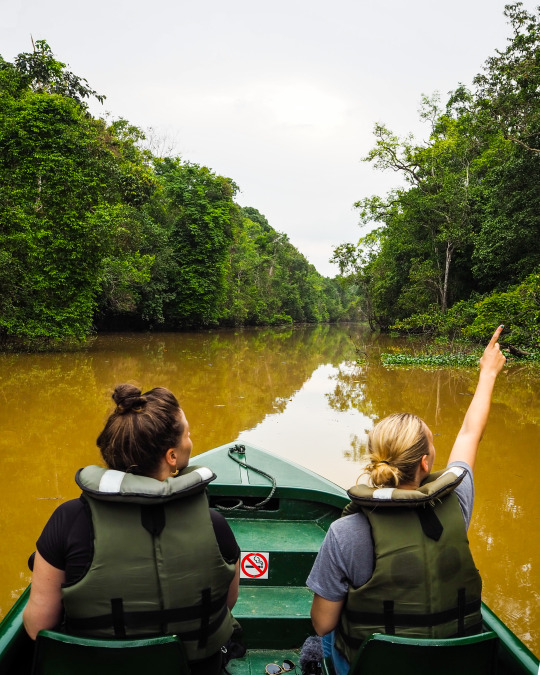
Photographers Meghan Young (@missmeghanyoung) & Kristen Kellogg (@borderfreetravels) track monkeys in Malaysia
The stuff I needed aside from those few personal items was all camera- and tech-related, which I thankfully had with me in my carry-on bag. (Pro tip: never check your camera gear in your checked bag if you can avoid it, as that will keep your cameras safe from both mishandling and potential theft). Truth is, I never board a plane without my cameras—especially if I’m headed to a destination as luscious as an island known for biodiversity. For my upcoming adventures this summer, my gear checklist will be virtually the same as it was in Borneo. Here’s how it’ll look:
- Olympus OM-D E-M10 Mark III Camera
- M.Zuiko 14-42mm EZ Lens (*kit lens included with Mark III)
- Olympus OM-D E-M1 Mark II Camera
- M.Zuiko 12-100mm f4 ProLens (*kit lens included with Mark II)
- M.Zuiko ED 40-150mm f2.8 PRO Lens (used for shots requiring a long lens, like landscapes and wildlife)
- M.Zuiko 17mm f1.8Lens (used for low light, portrait, and street photography)
- SanDisk Extreme PRO memory cards ranging from 32-128 GB
- 2-4 batteries per camera
- Camera charger for each camera
- “Shotgun” microphone for audio recording
- Lavalier microphone for audio recording
- Headphones to listen to video/audio playback
- Lens cleaning brush pen
- Lens cloths
- Lens cap “leashes” to ensure no caps fall off while traveling
- Interchangeable camera straps & clips, including 1 Slide, 1 Clutch, and 1 Capture
- Hard drive for memory card backup
Because that’s a fair amount of gear to keep organized, I like to keep it all in a backpack, where the weight is distributed between my shoulders and waist. I like bags that are intelligently designed, water resistant, and full of customizable compartments, like the 30L Everyday Backpack. That’s my go-to gear bag these days, whether I’m headed out on a weekend getaway or a Himalayan hike.
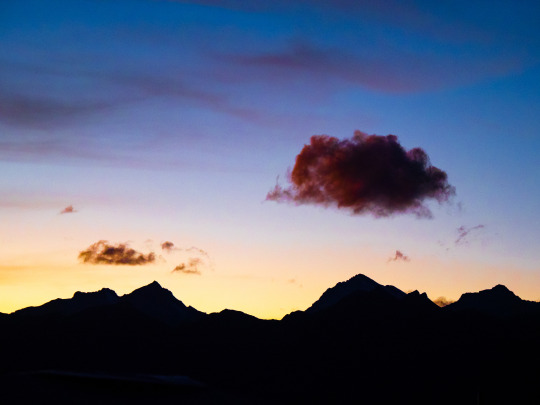
Sunset from the Himalayas along the Bumdra Trek, Bhutan
However you choose to pack your bags for adventure, it’s important not to get too bogged down in the unnecessary, especially when it’s summertime, since carrying any number of bags will make you sweat. How, pray tell, can you cut down on the packing list? Well, you may think you need the extra pair of swagtastic shoes, but you usually don’t. You may also think you need a few extra pairs of underwear, but—gasp!—you actually don’t need those either if you’ve got pairs you can wash in the sink that’ll quick dry overnight (e.g. ultralight mesh briefs).
You can also cut down on the photography gear if you’ve got the right cameras on hand. Mirrorless cameras have made leaps and bounds from the heavy DSLRs of the past, both in weight and technological ability. My favorite super-portable camera is the OM-D E-M10 Mark III, known for being not only lightweight and good-looking, but also super freaking smart.

This little guy weighs in at just 410 grams (including battery and memory card), but packs a ton of features. It has a tilting touch screen, built-in WiFi (which means you don’t need to lug around a memory card reader), and offers four shooting assist modes so users who are switching from smartphones to interchangeable-lens cameras can shoot without the guess work. Bonus: there are a bunch of “scene” modes that offer beautiful results, too. My favorite feature is the 5-Axis Image Stabilization, which helps you capture blur-free photographs (even at night, without that heavy tripod) and 4K video (sans that bulky stabilizer rig you might’ve seen DSLR-owners lugging around).
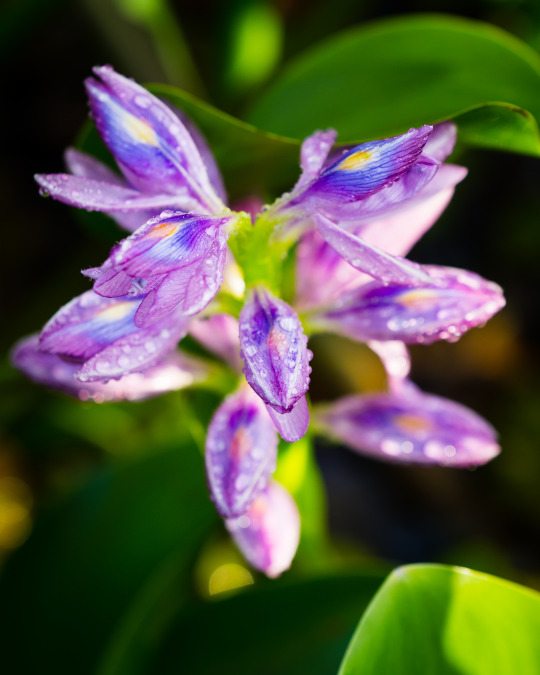
Crisp dewdrops sit atop a flowering plant in the Borneo Mangroves, shot with the Mark III
If you want to check out the OM-D E-M10 Mark III for yourself, it’s well worth perusing. If you click “Buy Now”, you’ll get $100 off the kit through June 2nd! The kit price (camera + M.Zuiko 14-42mm EZ Lens) is normally $799 USD, but right now it’s down to $699, so you should probably strike while the iron—and weather—are hot.
No matter where this summer brings you, remember: the most important things to pack on any journey are an open mind and a sense of adventure. Oh, and tooth paste. Please pack tooth paste.
Your friend,
Rachel
This piece is written in partnership with Olympus, though all opinions and experiences are compliments of yours truly.
#olympuspartner#photography#travel#rtw#journalism#international#borneo#malaysia#bhutan#trek#trekking#mountains#jungle#himalayas#sunset#wildlife#adventure#outdoors#Rachel rudwall#rachelroams#olympus#summer
3 notes
·
View notes
Photo

Today is World Animal Day I Chose To Highlight The Animals Of Borneo (where I lived as a young person). Starting in the upper left and going clockwise we have 1. Tarsier 2. Male Proboscis Monkey 3. Young Bornean Elephant 4. Rhinoceros Hornbill 5. Male Orangutan 6. Gibbon Couple 7. Female Proboscis Monkey Leaping 8. Bornean Elephant Mom & Child 9. Clouded Leopard 10. Gibbon 11. Colugo 12. Orangutan Mom & Child All animals on Borneo are endangered, some more then others. The biggest threat is deforestation/habitat loss. Illegal & quasi-legal logging along with vast palm oil plantations are 2 major threats. Possible solutions include ecotourism, carbon credits (wealthier countries pay for rainforests to not be cut down, wildlife corridors (large strips of rainforest to allow animals to travel from one intact stretch of rainforest to another - often alongside a river). There are other important projects that work with local communities to come with solutions for animals and humans to live in harmony. There are several charities working in Borneo including Borneo Orangutan Survival Organization, Kalaweit Wildlife Rescue, World Wildlife Fund (WWF), Nature Conservancy, International Animal Rescue and many more. #WorldAnimalDay #WorldAnimalDayBorneo #SaveAnimals #SaveTheRainforests #SaveAnimalHabitat #SaveBorneoRainforests #WWF #IAR #NatureConservancy #BorneoOrangutanSurvivalFoundation #Kalaweit #KalaweitWildlifeRescue #Tarsier #ProboscisMonkey #BorneanElephants #PygmyElephants #RhinocerosHornbill #BorneanOrangutans #Gibbons #CloudedLeopard #Colugo All photos are believed to be in the public domain or have Creative Commons licenses. Graphic designed/created by Jeri Rae. https://www.instagram.com/p/CF6nesHFZ01/?igshid=7udmm3k0kcrv
#worldanimalday#worldanimaldayborneo#saveanimals#savetherainforests#saveanimalhabitat#saveborneorainforests#wwf#iar#natureconservancy#borneoorangutansurvivalfoundation#kalaweit#kalaweitwildliferescue#tarsier#proboscismonkey#borneanelephants#pygmyelephants#rhinoceroshornbill#borneanorangutans#gibbons#cloudedleopard#colugo
0 notes
Text
VINTAGE GUITAR 1440mm Borneo Sape Music Musical Traditional Tribal Instrument Rainforest Fest

Vintage Guitar / Borneo Sape, a traditional instrument of Kenyah, Kayan and other ethnic tribes. The Sape is in excellent condition, except it needs new restringing.
History: The sape comes from the lute family. Thus, it is a musical instrument with a short neck. The shape of the body looks like a sampan / boat, often called the boat lute in Western countries. . Originally, sape strings were made from the Sago tree but now these have been replaced by guitar strings.
Dayak Sarawak vintage guitar, Borneo.
Length: 144 cm / 56.7 inches
Width: 22.5 cm / 8.9 inches
Side width: 12 cm / 4.7 inches
Weight: 4.8 kg / 10.5 lb
After packing: 8 kg / 17 lb
Volumetric weight(HxWxL/5000): 12 kg / 26 lb
I will ship via Courier Service (5-7 working days) worldwide, insured.
Shipping worldwide $115
#culture #guitar #instrument #music #musical #tradition
Read the full article
0 notes